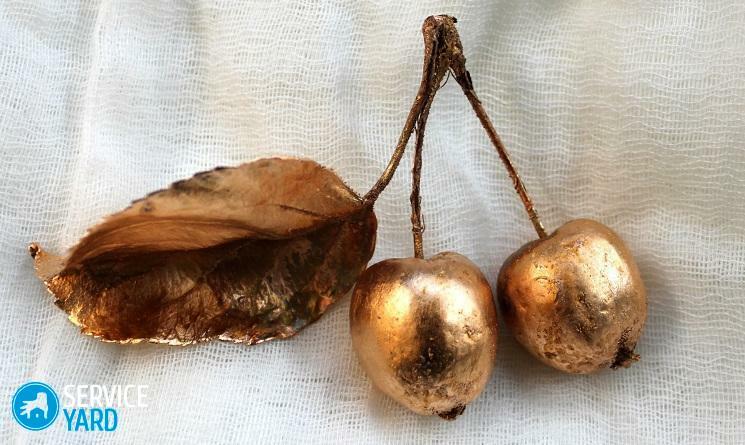
- What is it for?
- Spheres of use of electroplating
- Electroplating with electrolyte solution
- Electroplating in another way
In order to prepare a metal object for further processing, it needs to be coated with copper - this process is called electroplating. The principle of its action is the deposition on the surface of the workpiece from another metal, which is dissolved by a suitable means. From this article you will learn how to cover with copper metal at home, in order to realize all your subsequent ideas with the workpiece.
to the contents ↑What is it for?
The technology of electroplating involves the creation of a solution and the formation of various electrodes. During this process, copper ions, which are dissolved in the electrolyte, are attracted by the minus pole of the workpiece to its surface point.
Electroplating of metal parts in industry is used not only as the final processing process. It can be used to prepare the details for the subsequent operation( for example, chrome plating, nickel plating, silvering of any objects).
At home, most often, chemical copper plating is carried out. It should also be noted that there are many ways to conduct such a procedure, each of which has its advantages and disadvantages.
to the contents ↑Spheres of use of electroplating
Copper plating at home has become very useful lately. Most often, this procedure is suitable for the following purposes:
- In decorative. For example, in this way, different details are aged to give a vintage appearance.
- In electrotype. Very often, a copper layer is applied to souvenirs, jewelry.
- In the field of engineering. This is due to the low cost of copper plating.
- For applying a protective and decorative layer of a product.
- In order to restore or restore any parts.
Electroplating with electrolyte solution
This method can be coated with copper steel at home, as well as other parts except aluminum and zinc.
For the following procedure, the following materials must be prepared:
- Small copper plates.
- Conductive wire( it is better to stock up several meters).
- A current source whose voltage should not be more than 6 V.
- The rheostat to regulate the current.
- Ammeter.
- Electrolyte.
Important! The last component can be purchased in a special store, or you can make it yourself. To do this, make a solution of sulfuric acid and distilled water at a ratio of 2/100 ml. The desired solution will be obtained when you add to the composition no more than 20 g of copper sulfate.

The essence of the work is as follows:
- Clean the workpiece with sandpaper - this is necessary in order to remove the oxide film. Next, to cover with copper metal at home will not be so difficult.
- Degrease the metal object with a hot soda solution, rinse it with clean water.
- Pour the prepared electrolyte into a suitable container of glass.
- Dip two copper plates in prepared conductive wiring. Between the two plates of copper, the already defatted part is hung on the same wiring.
Important! Make sure that the plates of copper are completely immersed in the electrolyte.
- Next, the ends of the wires from the copper plates are connected to the positive terminal of the current source, and the part to the negative terminal. Further in the created electric network it is necessary to connect an ammeter with a rheostat. After the current is connected to the circuit, the rheostat needs to set it to about 15 mA per 1 cm of the surface of the detailed surface.
- Then the item is aged for about 15-20 minutes.
- After the time has elapsed, the power supply must be disconnected and the processed metal removed from the solution.
Eventually you will notice that you were able to cover with copper metal at home, because it will be completely covered with a thin shiny film.
Important! The thickness of the copper layer will depend on how long the part was held in the electrolyte.
to content ↑Electrolectrode by another method
This method is excellent for metals-exceptions that were named earlier - zinc and aluminum.
Algorithm of operation:
- Armed with stranded copper wire, remove insulation from both ends.
- Tear the soft wire from one side to get a simulated brush. Snap to this end an object that looks like a handle.
- The opposite side of the wire must be connected to the positive terminal of the power source.
Important! The voltage should be no more than 6 V.
- Prepare the electrolyte in the manner described above, pour it into a wide container - this is necessary for the convenience of dipping there "brush".
- Place a small piece of metal inside the prepared container. Connect it using a wire to the negative terminal of the current source also with a voltage of 6 V.
Important! The part must be pre-cleaned and degreased.
- The process of coating aluminum with copper at home is as follows: the cystic end of the wire should be dipped with electrolyte solution and carried to the surface of the processed metal object without touching it. Further - a negatively charged metal will attract copper ions to itself and its surface will acquire a copper film.
Important! Make sure that there is a small layer of electrolyte solution between the end of the riven wire and the metal( both the cathode and the anode must be wetted with this solution).
- After the part has acquired the desired color, it must be carefully dried, then rubed to shine.
It is possible to cover almost every metal part with a thin copper film, and it will be perfectly protected from unwanted external factors. About how to cover copper metal yourself, the conditions you learned from this article, and now you can do everything as expected.
